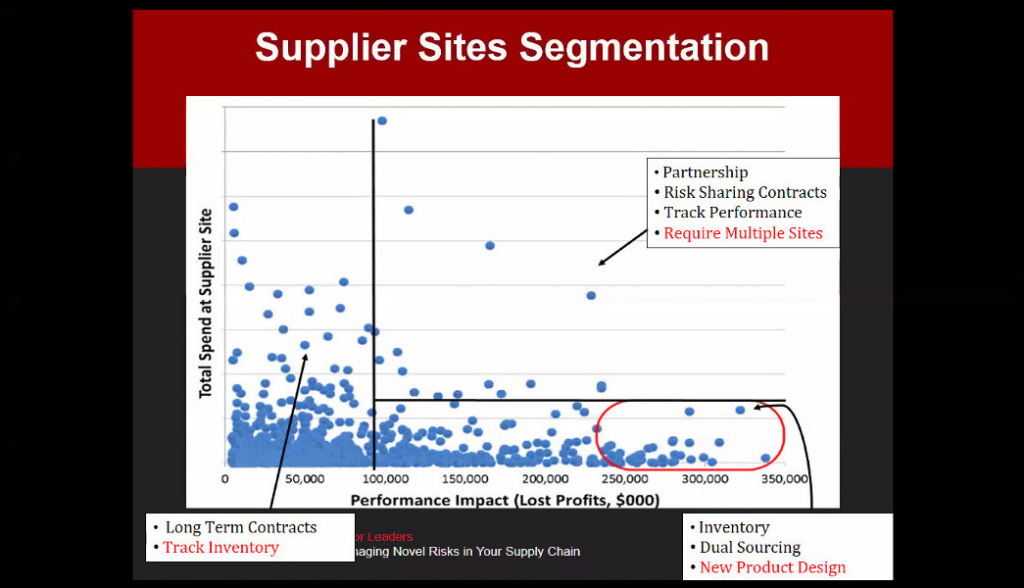
Photo image by Gerd Altmann from Pixabay
In our previous supply chain strategy work, we have used a constellation metaphor for the end-to-end supply chain, with each supply chain node (star in the constellation) providing value to the supply chain. The supply chain (constellation) should be designed to easily flex to alternate combinations of value, should one branch, or value node, of the supply chain be disrupted.
“Nearly 75% of companies report supply chain disruptions in some capacity due to Coronovirus”1
From Bain’s Management Tools Survey “Supply Chain Management synchronizes the efforts of all parties— suppliers, manufacturers, distributors, dealers, customers, and so on— involved in meeting a customer’s needs.”2
The direct supply chain implications and knock-on effects3 of COVID-19 lock-down are as unknown today as the characteristics of the disease itself.4 The implications of blind adherence to minimization of waste of excess inventory (e.g., one of 8 muda’s, or types of waste5), a goal of Toyota Production System and Lean Manufacturing, may be at least partially to blame for the lack of Personal Protection Equipment inventory by hospitals in particular and the healthcare system in general.6
The following are a number of topic areas for supply chain and operational consideration as you define your next-normal strategy, vision and roadmap.
BUILD RESILIENCE: UNDERSTAND SUPPLY CHAIN CAPABILITIES
- Consider the implications of trends and scenarios (e.g., health, geographic, political, technology, innovation, disruption, competitor demands, other industry sectors for competing for value of supplier node, etc.)
- Consider the constellation, value nodes, sub-tier suppliers, supplier muscle and resilience of your supply chain; For example, Toyota does not know its suppliers below tier 2, and there are many tier 4 suppliers7
- Consider “Just in Time + Just in Case8 (safety stock) inventory”
BUILD RESILIENCE: SUPPLY CHAIN9
- Review asset strategy including geographic footprint and concentration risks
- Transform for agility (e.g., modularity & workforce upscaling)
- Build robust supply chain function
BUILD RESILIENCE: GENERAL OPERATIONS10
- End-to-end digitization (e.g., customer experience, workforce productivity, flexibility)
- Transparency (e.g., spend, cost structure, strategic initiatives mapping)
- Future of work (e.g., digital comms and collaboration)
- Durable operations competitive advantage
DEFINE IMPLICATIONS NEXT-NORMAL STRATEGY ON SUPPLY CHAIN ASSETS AND OPERATIONS
- Clarify and communicate leader’s intent
- Push decision making downstream to increase speed of decision making and prevalence of feedback loops (e.g., Observe, Orient, Decide, Act (OODA))
- Segment, lead and manage your supply chain
- Define trigger events

Screen shot of HBS Program 4: Supply Chain11
Key takeaway: For lack of thousands of dollars of chemical inventory, Ford lost nearly $ 400MM in profit
Key Thought: While Supply Chain is a function and discipline into itself, leaders must understand enough about the immediate and next-normal supply chain implications for organizational muscle and operational resilience required to thrive across the range of multiple time-horizons, future and next-normal scenarios.
This article is part of our COVID series— “Getting to Your Next-Normal” – a four-part series originally distributed to clients and colleagues in early June, 2020.
Also see the remainder of the series
- Spiske, “75% of companies see supply chain disruptions due to Coronavirus,” Supply and Demand Executive, April 14, 2020 https://www.sdcexec.com/transportation/press-release/21128379/institute-for-supply-management-ism-75-of-companies-see-supply-chain-disruptions-due-to-coronavirus
- See “Supply Chain Management,” Bain & Company Management Tools, https://www.bain.com/insights/management-tools-supply-chain-management/
- For example and implication, see Haag, “New Threat to New York City: Commercial Rent Payments Plummet,” New York Times, May 21, 2020, https://www.nytimes.com/2020/05/21/nyregion/commercial-rent-NYC-coronavirus.html, sub-headline: “One landlord reported that 80 percent of retail tenants missed rent at the start of the month. The drop in commercial rent payments could imperil property tax collections that pay for city services”
- For example, MIS-C in children. See Wachtell “My Son Survived Terrifying Covid-19 Complications”, New York Times, May 21, 2020, https://www.nytimes.com/2020/05/21/opinion/mis-c-coronavirus-children.html for a personal perspective of emerging COVID disease presentation and implications in children and young adults.
- See “Toyota Production System,” Wikipedia, https://en.wikipedia.org/wiki/Toyota_Production_System
- See Professor Raman’s (Harvard Business School) comments citing several cases where carrying too little inventory, at a minor cost, had significant impact on business performance, including reference to COVID-19 Personal Protection Equipment. During the program, Professor Raman mentioned, while being a proponent of Toyota Production System, Lean had been misunderstood by blindly following minimal inventory management with little understanding of resilience of multiple tier suppliers and value of safety stock. From, Reeder, “MY NOTES to Harvard Business School’s Crisis Management for Leaders (4 of 5) SUPPLY CHAIN,“ https://www.linkedin.com/pulse/my-notes-harvard-business-schools-crisis-management-leaders-reeder-1e/
- See Reeder, “MY NOTES to Harvard Business School’s Crisis Management for Leaders (4 of 5) SUPPLY CHAIN,“ LinkedIn Article, https://www.linkedin.com/pulse/my-notes-harvard-business-schools-crisis-management-leaders-reeder-1e/
- Sneader, et al, “From thinking about the next normal to making it work: What to stop, start, and accelerate,” McKinsey, May 15, 2020 https://www.mckinsey.com/featured-insights/leadership/from-thinking-about-the-next-normal-to-making-it-work-what-to-stop-start-and-accelerate McKinsey puts forward 7 recommendation areas including, for example, No. 2 “From lines and silos to networks and teamwork” and No. 3 “From just-in-tune to just-in-time and just-in-case”
- Barriball, et al, “Jump-starting resilient and reimagined operations,” McKinsey, May 2020, https://www.mckinsey.com/business-functions/operations/our-insights/jump-starting-resilient-and-reimagined-operations
- Barriball, et al, “Jump-starting resilient and reimagined operations,” McKinsey, May 2020, https://www.mckinsey.com/business-functions/operations/our-insights/jump-starting-resilient-and-reimagined-operations
- “Crisis Management for Leaders” (5 program series), Harvard Business School Webinars (3.24 to 4.9.2020), presented to more than 1,000 alumni in each evening session at 5:30 pm ET via Zoom



4 Responses
Author’s Note:
NPR Podcast Planet Money provides another example of COVID Supply Chain interruptions on several supply chains, including lost opportunities for new car manufacturers due to microchip shortages – some of very little cost – causing a substitution-shift to used cars.
See 23M30 Podcast https://podcasts.apple.com/us/podcast/planet-money/id290783428?i=1000525191475
“So what” for going forward? Like the Ford example in this post, lean can be pushed too far. In your supply chain, consider the combination of “just in time” AND “just in case” inventory.